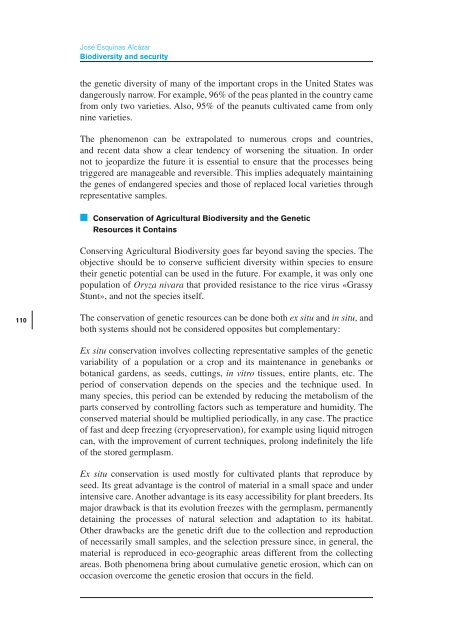Food security and global security - IEEE
Food security and global security - IEEE
Food security and global security - IEEE
- No tags were found...
Create successful ePaper yourself
Turn your PDF publications into a flip-book with our unique Google optimized e-Paper software.
José Esquinas AlcázarBiodiversity <strong>and</strong> <strong>security</strong>the genetic diversity of many of the important crops in the United States wasdangerously narrow. For example, 96% of the peas planted in the country camefrom only two varieties. Also, 95% of the peanuts cultivated came from onlynine varieties.The phenomenon can be extrapolated to numerous crops <strong>and</strong> countries,<strong>and</strong> recent data show a clear tendency of worsening the situation. In ordernot to jeopardize the future it is essential to ensure that the processes beingtriggered are manageable <strong>and</strong> reversible. This implies adequately maintainingthe genes of endangered species <strong>and</strong> those of replaced local varieties throughrepresentative samples.■■Conservation of Agricultural Biodiversity <strong>and</strong> the GeneticResources it ContainsConserving Agricultural Biodiversity goes far beyond saving the species. Theobjective should be to conserve sufficient diversity within species to ensuretheir genetic potential can be used in the future. For example, it was only onepopulation of Oryza nivara that provided resistance to the rice virus «GrassyStunt», <strong>and</strong> not the species itself.110The conservation of genetic resources can be done both ex situ <strong>and</strong> in situ, <strong>and</strong>both systems should not be considered opposites but complementary:Ex situ conservation involves collecting representative samples of the geneticvariability of a population or a crop <strong>and</strong> its maintenance in genebanks orbotanical gardens, as seeds, cuttings, in vitro tissues, entire plants, etc. Theperiod of conservation depends on the species <strong>and</strong> the technique used. Inmany species, this period can be extended by reducing the metabolism of theparts conserved by controlling factors such as temperature <strong>and</strong> humidity. Theconserved material should be multiplied periodically, in any case. The practiceof fast <strong>and</strong> deep freezing (cryopreservation), for example using liquid nitrogencan, with the improvement of current techniques, prolong indefinitely the lifeof the stored germplasm.Ex situ conservation is used mostly for cultivated plants that reproduce byseed. Its great advantage is the control of material in a small space <strong>and</strong> underintensive care. Another advantage is its easy accessibility for plant breeders. Itsmajor drawback is that its evolution freezes with the germplasm, permanentlydetaining the processes of natural selection <strong>and</strong> adaptation to its habitat.Other drawbacks are the genetic drift due to the collection <strong>and</strong> reproductionof necessarily small samples, <strong>and</strong> the selection pressure since, in general, thematerial is reproduced in eco-geographic areas different from the collectingareas. Both phenomena bring about cumulative genetic erosion, which can onoccasion overcome the genetic erosion that occurs in the field.
















